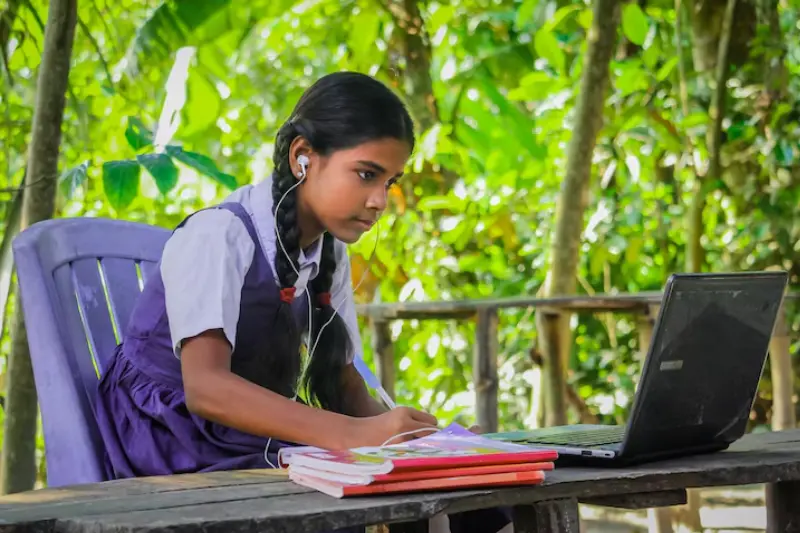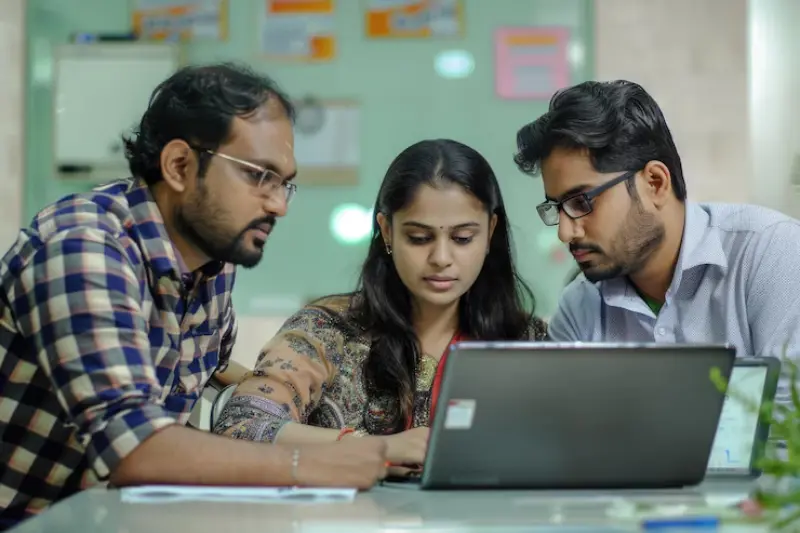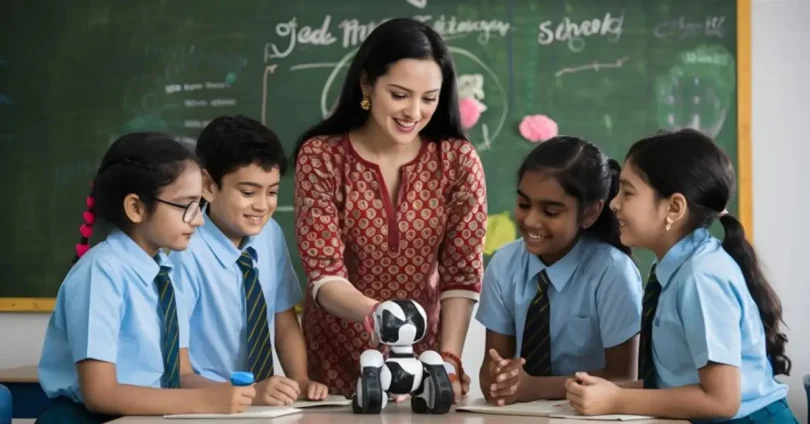Introduction:
Education in India is one of the most powerful tools for personal and national development. It shapes the way people think, helps them gain knowledge and skills, and prepares them for a better future. From ancient times, when India had world-famous learning centers like Nalanda and Takshashila, to the modern-day digital classrooms and universities, education in India has come a long way.
Today, India has a vast education system with millions of schools, colleges, and universities. The government has made efforts to make education free and accessible, especially at the primary level. Programs like the Right to Education (RTE) Act, mid-day meal schemes, and scholarships have helped more children go to school. Private schools and online education platforms have also grown rapidly, giving students more choices.
However, education in India still faces many challenges. There are big differences in quality between urban and rural schools. Many government schools lack basic facilities like clean drinking water, toilets, and trained teachers. The syllabus is often outdated, and students sometimes focus more on memorizing than understanding concepts. Also, higher education is becoming expensive, making it hard for poor families to support their children’s education.
Despite these problems, education in India is improving. With the help of technology, digital learning tools, and policy changes like the New Education Policy (NEP 2020), the country is working towards a more inclusive, practical, and modern education system. The future of education in India looks hopeful, and if the right steps are taken, it can truly transform the lives of millions.
What is “Education in India?”

Education in India refers to the system of learning and teaching that exists in the country, from primary school to higher education. It includes formal education in schools, colleges, and universities, as well as informal learning through online platforms and skill development programs.
The structure of education in India generally follows these stages:
- Pre-primary (nursery and kindergarten)
- Primary (Classes 1 to 5)
- Middle (Classes 6 to 8)
- Secondary (Classes 9 and 10)
- Higher Secondary (Classes 11 and 12)
- Higher Education (Colleges, universities, and vocational institutes)
Education in India is governed by both central and state governments. Institutions like CBSE, ICSE, and various state boards oversee school education, while higher education is managed by bodies like the UGC, AICTE, and universities.
The aim of education in India is to provide knowledge, build skills, and promote the overall development of students. It is also seen as a way to fight poverty, improve social status, and help in the economic growth of the country. While many positive changes have been made, there is still a long way to go in making education equal and excellent for all.
Why is Education in India Important?

Education in India is not just about going to school or earning degrees—it is a powerful tool that can shape individuals, families, and the future of the entire nation. Here’s why it is so important:
Empowers Individuals
- Helps people gain knowledge and skills for better life decisions.
- Increases confidence and independence.
- Opens doors to better job opportunities.
Drives Economic Growth
- Educated citizens contribute to industries, innovation, and entrepreneurship.
- Skilled workforce boosts productivity and income levels.
- Reduces poverty and supports sustainable development.
Promotes Equality
- Offers opportunities to everyone, regardless of background or gender.
- Helps bridge the gap between rich and poor.
- Empowers women and marginalized communities.
Improves Social Conditions
- Educated people are more aware of health, hygiene, and civic rights.
- Leads to better parenting, reduced crime, and healthier communities.
- Encourages social harmony and understanding.
Strengthens Democracy
- Creates informed and responsible citizens.
- Encourages people to participate in the democratic process.
- Promotes critical thinking and awareness of rights and duties.
Supports National Development
- Education builds professionals like doctors, engineers, teachers, and scientists.
- Fuels advancements in technology, infrastructure, and research.
- Helps India compete globally in various sectors.
Step-by-Step Guide on Education in India
Understanding how education in India works can help students, parents, and policymakers make better decisions. Here’s a simple step-by-step guide to how the Indian education system is structured and functions:
Pre-Primary Education (Ages 3–6)
- Nursery, Lower KG (LKG), and Upper KG (UKG)
- Focuses on basic learning, fun activities, and social skills
- Mostly available in private schools and some government-supported schemes like Anganwadi
Primary Education (Classes 1–5)
- Ages 6–10 (compulsory under the Right to Education Act)
- Focus on reading, writing, mathematics, and basic environmental studies
- Government schools offer free mid-day meals to encourage attendance
Upper Primary/Middle School (Classes 6–8)
- Ages 11–13
- Subjects expand to include science, social studies, and languages
- Exams and formal assessments start to be more common
Secondary Education (Classes 9–10)
- Prepares students for board exams conducted by CBSE, ICSE, or State Boards
- Subjects become more detailed and students begin career planning
- Completion leads to the Secondary School Certificate (SSC)
Higher Secondary Education (Classes 11–12)
- Known as “Junior College” or “Senior Secondary”
- Students choose a stream: Science, Commerce, or Arts
- Prepares students for competitive exams and university admissions
Higher Education (Colleges & Universities)
- Undergraduate degrees (B.A., B.Sc., B.Com, B.Tech, etc.)
- Postgraduate degrees (M.A., M.Sc., MBA, M.Tech, etc.)
- Options include regular universities, technical institutions (IITs, NITs), and open universities (IGNOU)
Vocational & Skill Development
- Offers short-term training and practical skills for jobs
- Includes government programs like Skill India, ITI training, and private courses
- Focused on employability and self-reliance
Online & Digital Education
- Platforms like SWAYAM, BYJU’S, and Khan Academy offer free or paid content
- Helps reach rural and remote learners
- Supported by Digital India initiative and New Education Policy (NEP 2020)
Advantages and Disadvantages of Education in India
| ADVANTAGES | DISADVANTAGES |
| India has thousands of schools, colleges, and universities across the country. | Rural and remote areas often lack basic facilities, infrastructure, and teachers. |
| Government schemes like the RTE Act, mid-day meals, and scholarships support free and inclusive education. | The syllabus in many schools is outdated and does not match modern industry needs. |
| Institutions like IITs, IIMs, and online platforms like SWAYAM and BYJU’S are helping raise education standards. | High competition and exam-focused learning cause stress and limit creativity. |
| English as a common medium of instruction helps students access global opportunities. | There is a wide gap in the quality of education between private and government institutions. |
| Students have a wide range of subjects and career options to choose from. | Practical and skill-based learning is often missing from regular classroom teaching. |
Common FAQs on Education in India
What is the current education system in India?
India follows a 10+2 system—10 years of school education followed by 2 years of higher secondary education. After that, students can choose college, university, or vocational training.
Is education in India free?
Yes, education is free and compulsory for children aged 6 to 14 under the Right to Education (RTE) Act. Government schools offer free education, books, and mid-day meals.
What are the main school boards in India?
The main boards are CBSE (Central Board of Secondary Education), ICSE (Indian Certificate of Secondary Education), and various State Boards. Some schools also follow international boards like IB or Cambridge.
What is the New Education Policy (NEP) 2020?
NEP 2020 is a new policy to improve the quality of education in India. It focuses on practical learning, skill development, flexibility in subject choices, and early childhood education.
Are there online education options available in India?
Yes, many platforms like BYJU’S, Unacademy, Vedantu, and government portals like SWAYAM offer online courses from school to college level.
What are the challenges in education in India?
Some major challenges include lack of infrastructure in rural schools, outdated curriculum, exam pressure, and inequality in access between rich and poor students.
Can students from rural areas access higher education?
Yes, many government schemes, scholarships, and reservation policies support rural and underprivileged students in accessing college education.
What career options are available after completing education in India?
Students can become engineers, doctors, teachers, civil servants, business professionals, IT experts, or pursue creative careers like design, writing, and media—depending on their interests and qualifications.
Conclusion:
Education in India plays a crucial role in shaping not just individual lives but also the future of the entire country. It helps people gain knowledge, build skills, and become independent. Over the years, India’s education system has grown with the support of both government and private efforts. Programs like the Right to Education Act, the New Education Policy (NEP 2020), and digital learning platforms have made learning more accessible and inclusive.
However, challenges still remain. Many students in rural areas face a lack of proper schools, qualified teachers, and basic infrastructure. There’s also a strong need to shift away from rote learning and move toward practical, skill-based education. Exam pressure, inequality in quality between public and private schools, and rising costs of higher education are other major issues.
Despite these problems, India is on the path to creating a better education system. With increased awareness, technology, and reforms, the country has a chance to make education truly equal, modern, and impactful. If these efforts continue and improve, education in India can unlock great potential, reduce poverty, empower all sections of society, and drive the nation forward in the global economy.
Bonus Points on Education in India
- National Education Policy (NEP 2020) is a major step toward making education more flexible, practical, and student-centered.
- Digital India Initiative is helping reduce the education gap between urban and rural areas through online learning and smart classrooms.
- Skill India Mission provides vocational training and job-oriented skills to students and school dropouts to improve employability.
- Mid-Day Meal Scheme encourages school attendance in government schools and helps improve children’s health and nutrition.
- Scholarships and Reservation Policies support students from economically weaker and disadvantaged backgrounds in accessing quality education.
- Globally Recognized Institutions such as IITs, IIMs, and IISc are ranked among the top in the world and attract international students and researchers.
- Rapid Growth of EdTech platforms like BYJU’S, Unacademy, and Vedantu have transformed learning with interactive and accessible content.
- Inclusive Education is being promoted through special programs for children with disabilities and learning difficulties, making the system more supportive and equal.







